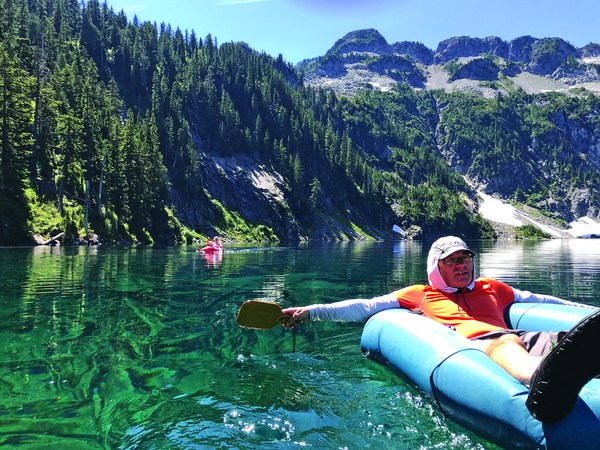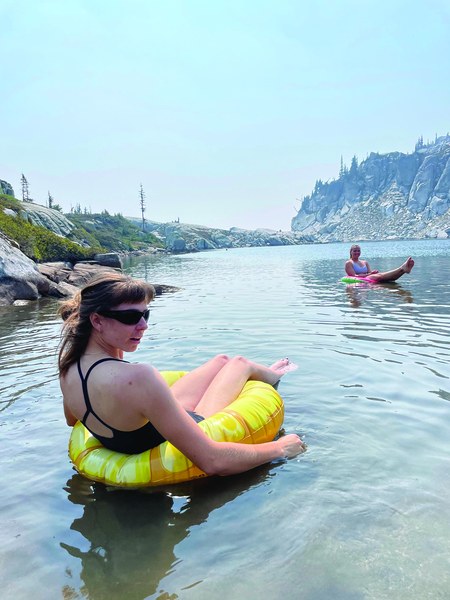
At The Mountaineers, we strive to recreate mindfully and respectfully on the traditional lands of Native peoples. After the print edition of our magazine, we recognized the implications of using terms like “bagging” which are associated with a culture of conquest over nature. To honor our commitment to mindful engagement with the outdoors and the connections of Native peoples to the lands we love, we have revised the online version of this article to include ways to incorporate land acknowledgment and mindful and respectful recreation into your alpine lake visits.
"Hiking — I don't like either the word or the thing. People ought to saunter in the mountains, not hike!"
– John Muir
On a hot August afternoon, I quickly stuff the final bites of burrito in my mouth as I look back one last time at the jade-blue mountain lake we’re about to leave. The lake is surrounded by brushy, amber-meadow, hushed in the glow of high summer. I had jumped into the cool water the moment we arrived, feeling the heat and fatigue leave my body to be replaced by a sense of buoyancy and freedom. This lake is on the way to our campsite in the Olympics, where we will spend the night before scrambling Mt. Henderson. Even though I’m excited for the overnight camp and scramble, I feel a tug as we pack up, wishing I could linger by the water a little longer.
When I recently heard the term lake bagging, I was immediately intrigued. As it turns out, I’m not the only one who wants to linger by - or as John Muir would say, saunter in - the wilderness. Lake bagging, despite the name, tends to mean the opposite of peak bagging to most who do it. Many enjoy hiking or scrambling to mountain lakes to jump in or sit by the shore for no reason other than to connect with nature, experience beauty, and have fun. Rather than collecting bragging rights, lake baggers return home with wet shorts in a plastic bag and the memory of being immersed in clear, glacial water surrounded by a ring of craggy peaks.
 Packrafting in Copper Lake, Alpine Lakes Wilderness. Photo by Deb Fox.
Packrafting in Copper Lake, Alpine Lakes Wilderness. Photo by Deb Fox.
How Mountaineers are lake bagging
To learn more about exploring alpine lakes, I caught up with three members of The Mountaineers who are passionate and intentional about lake bagging: Deb Fox, Allison Tapert, and Kari Durr.
For Deb, a 24-year member and graphic artist, the main draw of lake bagging is the vivid colors. “When I see a jewel-like lake with this searing monolith behind it, it’s hard not to be gobsmacked by the beauty: the white of the granite, the blue of the water, and the green of the foliage,” she said. “A friend once gave me a grand tour of a major jewelry store on Rodeo Drive and he took out all these jewels costing tens of thousands or even millions of dollars. They had this refractory quality, sparkle, and brilliant color — and alpine lakes are just like that. When you see the wind kick up with sunlight on the water, it starts to sparkle. They can have a sapphire color, and in the shallows, a cobalt hue that turns into cyan and blue topaz.”
For Allison, who joined The Mountaineers this year, turning 50 was the catalyst for what has become years of alpine lake adventures. After realizing how little free time she had taken for herself over the years, she took a tally of the activities she loved most: swimming, hiking, and being outside. She came up with the goal of visiting 50 mountain lakes for her fiftieth year, and since then has continued to visit dozens of lakes every season.
“I don’t love the term lake bagging,” Allison said. “It sounds like a conquest, whereas for me it’s really about connection with nature. Now I can embrace my birthdays because I'm getting out in the woods, connecting with new people, and swimming in the most beautiful places I've ever seen. There’s nothing like jumping into the water and seeing these mountain peaks behind. It just lights me up; it’s gorgeous.”
Kari, a Conditioning Hiking Series leader and former administrator, is currently working toward earning multiple branch-specific Alpine Lake badges. She says her love for mountain lakes started at a young age while hiking in the Cascades with her family. “I can still recall basking in the sun at the lakeshore with my sandwich and gazing around with awe at the stunning alpine surroundings, listening to the sound of the breeze rustling over the surface, keeping my eyes peeled on the high meadows for wildlife, and sometimes soaking my feet in the clear, ice-cold waters,” she said. “All of that was such a wonderful reward for the effort it took to huff and puff myself up the trail. Now I'd rather hike to an alpine lake than anywhere.”
 Floating in Thunder Mountain Lake. Photo by Lorraine Yerger.
Floating in Thunder Mountain Lake. Photo by Lorraine Yerger.
The freedom of lake bagging
If you’re like me and inspired by these lake bagging accounts, it’s time to jump in! There are over 8,000 alpine lakes to choose from in Washington State. Let your sense of adventure guide you; the rules of lake bagging are ultimately up to you. Just remember to stay safe and respect the lands and waters.
TIPS FOR (SAFELY!) TAKING THE PLUNGE
- Find lakes that interest you by searching The Mountaineers website or Google Earth, where you can see how large a lake is, whether it is accessible via trail, and if there are any other lakes nearby that you might want to visit.
- Acknowledge Native lands and peoples. Research and learn about the Native peoples whose traditional lands you’ll be visiting and consider how to incorporate acknowledgment into your time outdoors.
- Practice Low Impact Recreation. Wipe off any sunscreen or insect repellant before jumping in to avoid contaminating the water, and be sure to camp at least 200 feet from the shoreline if you’re staying overnight.
- Be aware of the risk of hypothermia, especially on cooler days. If you’re cold when you get out of the water and the air temperature is dropping, your body temperature could become too low.
- Let your body acclimate before jumping in. Entering the water too quickly could put you at risk of cold shock. Instead, try wading in slowly and splashing water on your face and neck to help adjust to the temperature of glacier-fed water.
- Remember The Ten Essentials, especially navigation tools, a headlamp, an emergency blanket or bivy sack, and warm clothes to change into after a plunge. Navigation tools are important as alpine lakes can be difficult to reach, even if they’re on the trail.
- Recreate mindfully and respectfully by seeking connection, belonging, and community with the natural world.
- Earn Mountaineers Alpine Lakes Award badges for extra inspiration and motivation.
- Be creative and have fun! Bring a wetsuit, blow-up raft, or sketch journal. If you can, swim out to the middle of the lake and float on your back for a while to feel fully immersed. Skinny dip if the spirit moves you!
KARI DURR'S FAVORITE ALPINE LAKES FOR BEGINNERS
- Lake Ann (at Mt. Baker): Located in a stunning setting a stone's throw away from Mt. Shuksan, Lake Ann offers close-up views of the Lower Curtis Glacier.
- Larch Lake (via Ewing Basin): Looking for solitude? This lake is a good choice, as the trail is generally quiet. In the fall, the namesake larches surrounding the lake glow like amber.
- Spectacle Lake (off the PCT near Salmon la Sac): This lake is close to Seattle and particularly nice on a hot day. The route via Pete Lake winds through fields of pink fireweed and stands of silver trees with views of the Three Queens and involves a (sometimes rather exciting!) ford of Lemah Creek. Delate Creek Falls, on the way to Spectacle, offers a cool respite from the summer sun.
This article originally appeared in our summer 2024 issue of Mountaineer magazine. To view the original article in magazine form and read more stories from our publication, visit our magazine archive.
 Jessica Hirst
Jessica Hirst